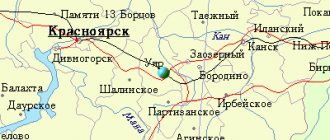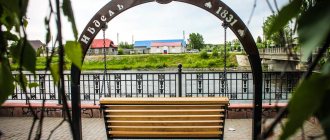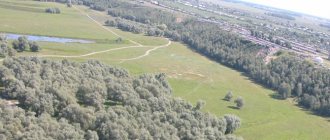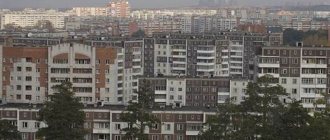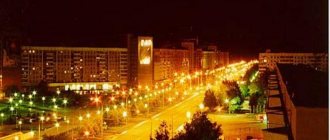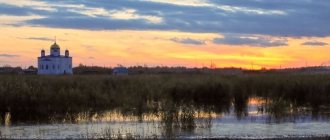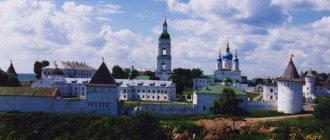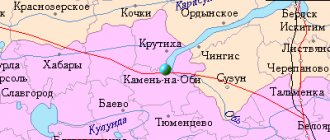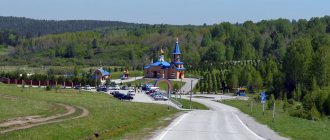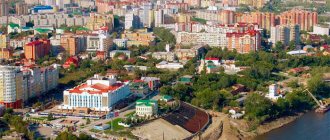City in Primorsky Krai, Russia
| Lesozavodsk Lesozavodsk | |
| City [1] | |
| Ussuri River in Lesozavodsk | |
| Coat of arms | |
| Location of Lesozavodsk | |
| Lesozavodsk Location of Lesozavodsk Show map of Russia Lesozavodsk Lesozavodsk (Primorsky Territory) Show map of Primorsky Krai | |
| Coordinates: 45°28'N 133°24'E / 45.467°N W. 133.400° E. / 45.467; 133 400 Coordinates: 45°28'N 133°24'E. / 45.467 ° N W. 133.400° E. / 45.467; 133 400 | |
| A country | Russia |
| Federal subject | Primorsky Krai [1] |
| Based | 1924 |
| City status from | 1938 |
| Government | |
| • Head | Andrey Sukhanov |
| Height | 80 m (260 ft) |
| population size (2010 Census) [2] | |
| • General | 37 034 |
| • Evaluate (2018) [3] | 35 506 ( -4,1% ) |
| Administrative status | |
| • Subordinate | City of Lesozavodsk of regional subordination [1] |
| • Capital from | City of Lesozavodsk of regional subordination [1] |
| Municipal status | |
| • Urban district | Lesozavodsky urban district [4] |
| • Capital from | Lesozavodsky urban district [4] |
| Timezone | UTC+10 (MSK+7[5]) |
| Postal code [6] | 692031, 692033, 692036, 692038–692042, 692047–692049 |
| Dial code(s) | +7 42355 |
| OKTMO ID | 05711000001 |
| Web site | lesozavodsk-pk.rf |
Lesozavodsk
(Russian: Lesozavodsk) is a city in Primorsky Krai, Russia, located on the Ussuri River (a tributary of the Amur), 10 kilometers (6.2 mi) from the Sino-Russian border and approximately 300 kilometers (190 mi) north of Vladivostok. . , then the administrative center in the region. Population: 37,034 (2010 census); [2] 42,185 (2002 census); [7] 44,065 (1989 census); [8] 37,000 (1972).
History[edit]
The first settlement on this site was founded in 1924 in connection with a sawmill. [ citation needed
] The settlement was originally called
Dalles
(Dalles), [
citation needed
] from the Russian word
dalny
for "distant" (referring to the Far East) and
les
for "forest".
In 1932, Dulles was merged with the nearby village of Novostroika
, given the status of an urban village and renamed Lesozavodsk.
Lesozavodsk was given city status in 1938[ edit
]
Lesozavodsk // “Historical Encyclopedia of Siberia” (2009)
LESOSAVODSK , a city of regional subordination in the Primorsky Territory, the administrative center of the district of the same name. It is located on the Ussuri Lowland, at the intersection of the Ussuri River (a tributary of the Amur) with the Trans-Siberian Railway and the Vladivostok-Khabarovsk highway, 349 km northeast of Vladivostok.
Railway station Ruzhino. The village of Lutkovka arose in 1894, and the villages of Medveditskaya and Donskaya in 1895. In 1924, construction began on a timber mill, which created the village of Dalles. In 1932, the villages of Dalstroy and Novostroika, which arose at the timber mills, were combined with adjacent villages into one workers’ village called Lesozavodsk, which was transformed into a city in 1938. Population (thousand people): 1939 - 24.1; 1959 - 32.1; 1970 - 35.0; 1979 - 38.8; 1989 - 44.0; 1998 - 46.0; 2002 - 42.2; 2007 - 41.7.
Lesozavodsk developed together with the Ussuriysk timber mill, which in the early 1960s. transformed into a lumber mill that produced in the late 1980s. up to 40 types of products. The city expanded in a northern direction and was connected to the Ruzhino station, which had a locomotive and car repair depot. Main industrial enterprises: JSC "Ussuri woodworking plant", factories: biochemical, "Lammebel", garment factory "Ussuri"; food enterprises: meat processing plant, dairy plant, bakery plant. In the vicinity of Lesozavodsk there are deposits of granite, limestone, pebbles, gravel, construction sand, clay, etc. In the 1950s. 3 secondary, 3 seven-year and 4 primary schools, a forestry technical school, a vocational school. In the 1970s medical School. In modern Lesozavodsk there are 2 secondary schools, a medical school, the Primorsky Industrial and Economic College, 2 vocational schools, a branch of the Far Eastern State Technical University, a cultural center, an officers' house, a library, and an art school. To the southeast of Lesozavodsk there is a resort called Shmakovka.
In 2001, the coat of arms was approved: in a green field with a thinly bordered gold azure St. Andrew's cross in the upper left corner there is a standing golden tiger, in the lower right corner there is a purple lotus flower, thinly bordered in gold. The blooming lotus is adopted as a symbol of Lesozavodsk and the region, indicating the ecologically clean environment and relict lakes located around the city. The image of a lotus in a composition with a Ussuri tiger (symbol of Vladivostok) symbolizes the wealth of the region and its regional affiliation. In 2006, the coat of arms of the Lesozavodsky mountain district was approved: the field of the shield is divided by the left golden band into green and azure, on top of everything there is a purple lotus flower.
In the free part there is the coat of arms of the Primorsky Territory. Azure shows that the mountain district is located on the banks of one of the largest rivers of the Far East - the Ussuri - and is surrounded by relict lakes where lotus grows; it is also the color of water and sky, symbolizing beauty and grandeur; gold is a symbol of the wealth of mineral resources, flora and fauna, justice and generosity; greenery symbolizes rich nature and forest wealth, it is also the color of freedom, hope, prosperity and abundance; The lotus flower is a symbol of longevity and resurrection, dignity, strength and power.
Lit.: Great Soviet Encyclopedia. 1954. T. 14; 1973. T. 25; Cities of Russia: Encyclopedia. M., 1998; All Russia. Cities and towns: Encyclopedia. M., 2001.
V.M. Markets
Climate[edit]
Lesozavodsk has a humid continental climate with cold and dry winters due to the Siberian Anticyclone and hot and humid summers due to the Southeast Asian monsoons.
Climate data for Lesozavodsk
| Month | Jan | Feb | Mar | Apr | May | Jun | Jul | Aug | Sep | October | But I | December | Year |
| Average high °C (°F) | -12,1 (10,2) | -7,2 (19,0) | 2,5 (36,5) | 14,1 (57,4) | 21,0 (69,8) | 25,2 (77,4) | 27,7 (81,9) | 27,2 (81,0) | 22,0 (71,6) | 13,6 (56,5) | 1,6 (34,9) | -8,7 (16,3) | 10,6 (51,0) |
| Daily average °C (°F) | -18,0 (-0,4) | -13,5 (7,7) | -4,0 (24,8) | 7,0 (44,6) | 14,1 (57,4) | 19,3 (66,7) | 22,6 (72,7) | 21,8 (71,2) | 15,3 (59,5) | 6,7 (44,1) | -4,4 (24,1) | -14,5 (5,9) | 4,4 (39,9) |
| Average low °C (°F) | -23,9 (-11,0) | -19,8 (-3,6) | -10,5 (13,1) | -0,1 (31,8) | 7,2 (45,0) | 13,4 (56,1) | 17,5 (63,5) | 16,4 (61,5) | 8,6 (47,5) | -0,2 (31,6) | -10,4 (13,3) | -20,3 (-4,5) | -1,8 (28,7) |
| Average precipitation, mm (inches) | 11 (0,4) | 8 (0,3) | 16 (0,6) | 26 (1,0) | 49 (1,9) | 61 (2,4) | 98 (3,9) | 116 (4,6) | 79 (3,1) | 42 (1,7) | 22 (0,9) | 13 (0,5) | 541 (21,3) |
| [ quote needed ] | |||||||||||||
The city of Lesozavodsk is the administrative center of the Lesozavodsky district of Primorsky Krai. It is located at the intersection of three highways - river, railway, highway. Here the Ussuri River flows from south to north, and the Far Eastern Railway crosses the area almost parallel to it. To the east of the railway there is the Vladivostok-Khabarovsk highway. The city was formed in 1938 from the merger of the villages: Donskoye, Lutkovka, Medveditskoye and Ruzhino station. Lesozavodsk is a young city, but has a hundred-year history. Until the 90s of the nineteenth century, on the territory of the modern Lesozavodsky district there were only four Cossack settlements along the border with China (founded in the 50-60s of the XIX century). The mass settlement of the city and region by peasants is associated with the construction of the East Siberian Railway and its the southern branch of the Ussuri section connecting Vladivostok and Khabarovsk. In connection with the construction of the railway, the issue of road protection and economic development of this territory arose. In 1894, near the Ussuri railway station, settlers from the Kiev, Poltava, and Chernigov provinces founded the first peasant village of Lutkovskoye on the territory of the modern Lesozavodsky district . In 1895, the Don Cossack settlement of Ust-Medveditsky arose on the high right bank of the Ussuri River. On the opposite low bank, opposite the Ussuri station, in the same year another party of Don Cossacks founded the village of Donskaya. Since the beginning of the 20th century, the village of Lutkovka has been the administrative center of the Lutkovsky volost of the Iman district. Stanitsa Donskaya - Don stanitsa district of the Ussuri Cossack army. Trade was concentrated in Lutkovka. Peasants from nearby villages came to the weekly markets. Before the revolution, there were two churches in the city: the Holy Trinity (Lutkovskaya), the Church of the Donskaya Icon of the Mother of God in the village of Donskaya. Also, before the revolution, industrial enterprises began to appear Lesozavodsk The most significant was the sawmill, which later became a factory, owned first by Shabanov and then by Beredin. In 1922, the Dulles State Trust was created, which included the Beredin plant. In 1932, the settlements “Dalles”, “Novostroika” with the villages of Donskoye, Lutkovka, Medveditskoye, as well as the Ussuri railway station became part of the newly created working village of Lesozavodsk . During the pre-war five-year plans, the Ruzhinsky railway junction with a locomotive and carriage depot, a power plant and other facilities was built on the territory of the modern city. Local industrial enterprises emerged. Lumber mills 1-2 turned into the largest enterprise in the Far Eastern Territory and laid the foundation for the Ussuri Order of the Red Banner of Labor woodworking plant, as well as the city. By a resolution of the Presidium of the All-Russian Central Executive Committee of February 2, 1938, the working village of Lesozavodsk, Shmakovsky district, Ussuri region of the Far Eastern Territory, was transformed into a city, retaining the name Lesozavodsk . Phone code: +7 42355 City websites: https://lesozavodsk.net, https://lesozavodsk.ru, https://lesozavodsk-pk.rf
Lesozavodsk
The territory of the city at the turn of the 19th–20th centuries
The history of the city of Lesozavodsk goes back to the end of the 19th century, when in 1894 settlers from the Kyiv, Poltava and Chernigov provinces began to found the first settlements on the banks of the Ussuri River, which gave rise to one of the future cities of the Primorsky Territory. Thus, in 1894 the village of Lutkovka appeared, in 1895 - the village of Tikhmenevo, the villages of Donskaya and Medveditskaya. The population of villages and villages was engaged in animal husbandry and agriculture. In 1897, a wooden church was built in the village of Donskoy in honor of the Don Icon of the Mother of God.
At the turn of the 19th and 20th centuries, the construction of the Trans-Siberian Railway was underway, and large coastal cities - Vladivostok and Nikolsk (future Ussuriysk) - developed rapidly. There was a need to create a sawmill in Primorye. Small private timber processing factories began to appear. The first small sawmill was founded on the left bank of the Ussuri River, next to the railway, it belonged to Borodin. In the village of Lutkovka there was a first aid post, the only one for three villages in the district, and there was a school.
Since 1900, numerous settlements arose one after another: in 1899 - Tarashcha, in 1900 - Glazovka, Elizovetovka, Ruzhino, in 1901 - Nevskoye, Orlovka, Innokentyevka, in 1902 - Metrofanovka, Turgeneva, in 1907 - Petrovka, in 1909 - Panteleimonovka, Pchelnoye, Ilmovka. From 1901 to 1910 13 new villages with 1,775 farms arose here. The Lutkovskaya volost was formed with its center in the village of Lutkovka. The volost administration was subordinate to the Iman district administration.
Before the October Revolution, the inhabitants of Donskoy, Lutkovka, and Medveditsky were mainly engaged in agriculture, sowing rye, wheat, soybeans, oats, and growing vegetable gardens and melons. In the area of Tyukhmenev and Kabarga, the Koreans sowed rice. Few were engaged in crafts. It was mainly the Chinese who traded, but the Russians also had their own shops. One of the enterprises was the Pilyugin seasonal sawmill, where 2 manually operated frames worked. The timber was floated down the Ussuri River and then sent abroad. Sawing was done in the summer, and most of the workers were fired during the winter.
After the revolution
During Soviet times, the pace of economic development of the territory on the site of the future Lesozavodsk accelerated. Private enterprises were nationalized. In 1924, on the right bank of the Ussuri, a state sawmill was founded - Timber Plant No. 1, which later grew into the Ussuri Woodworking Plant, one of the largest in the Far East. At the same time, the development of the workers' village of Dalles, which arose at the enterprise, began. In 1925, the Ussuri timber industry enterprise was organized. In 1931 it was liquidated, and on its basis the Ussuri Rafting Office was created, which over time became one of the largest timber industry enterprises in the Primorsky Territory.
In 1930, reconstruction of the former factory of the merchant Borodin began, new workshops appeared here, and technical equipment increased. However, on the eve of the plant's commissioning in July 1933, it burned down. The government loss amounted to about 11 million rubles. But already in 1934 the enterprise was rebuilt and equipped with the latest equipment at that time.
The rapid development of the forestry and wood processing industries and the construction of the settlements of Novostroika and Dalles resulted in a change in the status of this populated area. By a decree of the All-Russian Central Executive Committee of June 1, 1932, the settlements of Novostroika and Dalles, which arose at the Ussuri timber mills, with the adjacent villages of Lutkovka, Medveditskoye, Donskoye and the Ussuri station, were united into the boundaries of a single settlement, which was categorized as workers' settlements and received the modern name Lesozavodsk.
In 1932, work began on the construction of the Ruzhino railway junction, where a railway settlement grew. By 1936, the construction of the hub was basically completed.
On February 2, 1938, the working village of Lesozavodsk, belonging to the Shmakovsky district of the Ussuri region of the Far Eastern Territory, was transformed into a city.
In 1939, a bakery began operating, as well as other local enterprises: a food processing plant, an industrial plant, a creamery, and a consumer services plant.
Years of war and post-war period
About 10 thousand timber workers fought on the fronts of the Great Patriotic War, every sixth did not return home. The workers of the timber mill, railway and agricultural enterprises, the rafting office, and other enterprises and institutions fought heroically in the war. Lumber workers fought in Belarus, Ukraine, the Kursk Bulge, and took part in the battles for Moscow, Stalingrad, and Leningrad. Fyodor Grigoryevich Litvinyuk was awarded the title of Hero of the Soviet Union, Timofey Ivanovich Skidan became a full holder of the Order of Glory. Many timber workers took part in the war with Japan.
Those remaining in the rear worked selflessly. In a short time, production of products for military needs was mastered in Lesozavodsk. Here they produced ammunition drags, pontoon bridges, aircraft plywood, regular and artillery skis, and other products needed by the front. In 1942 alone, 35,000 pairs of skis, 500 pairs of artillery skis, 600 drags, and 300 pontoon bridges were produced. City residents donated their savings for the production of military equipment.
After the war, Lesozavodsk began to develop at a particularly rapid pace; the city became a major center of the forestry and woodworking industries of Primorye. The Ussuri woodworking plant, whose director for many years was Moisei Ivanovich Budnik, accounted for about half of the total industrial production of the city of Lesozavodsk. In 1956, the House of Culture of the woodworking plant was opened.
In 1972, the largest biochemical plant in the Far East, the Lesozavodsky Biochemical Plant, came into operation. In 1974, the Ussuri garment factory, at that time the largest in Primorye, was put into operation and began production. In 1976, the Yunost cinema welcomed its first spectators. In 1987, a furniture factory was put into operation, producing laminated boards, and later cabinet furniture. On June 5, 1988, the Lesozavodsk History Museum opened to visitors; the opening was timed to coincide with the 50th anniversary of the city.
The radical political and economic changes in the life of the country that occurred in the 1990s also affected the life of Lesozavodsk: private enterprises began to emerge in place of the giants of the woodworking and forestry industries. A garment factory and a biochemical plant were closed.
Map
| Lesozavodsk: maps |
Lesozavodsk: photo from space (Google Maps) Lesozavodsk: photo from space (Microsoft Virtual Earth)
| Lesozavodsk. Nearest cities. Distances in km. on the map (in brackets along roads) + direction. Using the hyperlink in the distance , you can get the route (information courtesy of the AutoTransInfo website) | |||
| 1 | Kirovsky | 42 (45) | YU |
| 2 | Dalnerechensk | 57 (113) | NE |
| 3 | Novopokrovka | 95 (186) | NE |
| 4 | Spasskoye | 104 () | SW |
| 5 | Spassk-Dalniy | 106 (123) | SW |
| 6 | Yakovlevka | 115 (159) | YU |
| 7 | Luchegorsk | 128 (163) | NE |
| 8 | Stone-Fisherman | 134 (371) | SW |
| 9 | Chernigovka | 141 (161) | SW |
| 10 | Arsenyev | 144 (207) | YU |
| 11 | Chuguevka | 149 (276) | YU |
| 12 | Khorol | 154 (336) | SW |
| 13 | Monastery | 158 () | SW |
| 14 | Sibirtsevo | 159 (182) | SW |
a brief description of
Located on the Ussuri Lowland, at the intersection of the river. Ussuri (tributary of the Amur) of the Trans-Siberian railway. highway, 349 km northeast of Vladivostok. Railway Ruzhino station.
To the southeast of Lesozavodsk there is a balneological resort Shmakovka (carbon dioxide, hydrocarbonate mineral water).
Lakes Lobyntsevo, Goncharovo, Maloe (nesting waterfowl; lotus). Hills Glazovskaya, Bezymyannaya (ledum).
Territory (sq. km): 3064
Information about the city of Lesozavodsk on the Russian Wikipedia site
Historical sketch
In 1924, the construction of a timber mill began, at which the village of Dalles arose; Nearby was the village of a timber mill, which previously belonged to the merchant Borodin.
In 1932, the villages of Dalstroy and Novostroika, which arose at the timber mills, were combined with adjacent villages into one working village called Lesozavodsk. In 1938 it was transformed into the city of Lesozavodsk.
Economy
JSC "Ussuri Woodworking Plant". Factories: biochemical, "Lammebel". Garment factory "Ussuri". Food enterprises: meat processing plant, dairy plant, bakery.
In the Lesozavodsky district, grains, soybeans, potatoes, and vegetables are grown. Meat and dairy cattle breeding.
Deposits of granite, limestone, pebbles, gravel, construction sand, clay, etc.
Main enterprises
FORESTRY INDUSTRY
LLC "Ussuriles"
692060, Primorsky Krai, Lesozavodsk, st.
Sverdlova, 24 Offers:
Lumber, blanks for construction products
GARMENT INDUSTRY
OJSC Lesozavodsky Industrial Plant
692060, Primorsky Territory, Lesozavodsk, st.
Belova, 8 Offers:
Bed linen, workwear
Universities of the city
Lesozavodsk Institute of Management Technologies (branch) of the Far Eastern State Technical University (FEPI named after V.V. Kuibyshev)
692042, Primorsky Territory, Lesozavodsk, Proletarskaya st., 7
Museums, galleries, exhibition halls
Museum of the History of Lesozavodsk 692031, Primorsky Territory, Lesozavodsk, st. 9 January, 64 Phone(s): (42355) 93-843 Website: https://arseniev.org/
| Population by year (thousands of inhabitants) | |||||||
| 1939 | 24.1 | 1996 | 46.8 | 2007 | 41.7 | 2015 | 36.3 |
| 1959 | 32.1 | 1998 | 46.0 | 2008 | 41.4 | 2016 | 36.0 |
| 1967 | 35 | 2000 | 45.5 | 2010 | 41.0 | 2017 | 35.8 |
| 1970 | 35.0 | 2001 | 45.3 | 2011 | 37.0 | 2018 | 35.5 |
| 1979 | 38.8 | 2003 | 42.2 | 2012 | 36.8 | 2019 | 35.3 |
| 1989 | 44.1 | 2005 | 42.2 | 2013 | 36.9 | 2020 | 35.1 |
| 1992 | 45.4 | 2006 | 42.0 | 2014 | 36.6 | 2021 | 34.8 |
